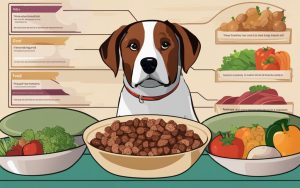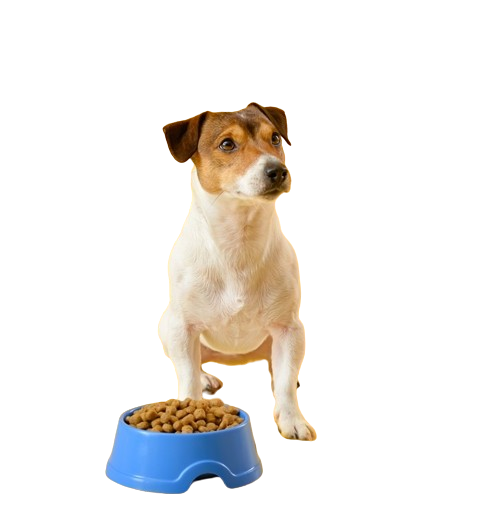Are Dogs Omnivores: When it comes to our furry companions, understanding their dietary needs is crucial for their overall health and well-being. One question that often arises is whether dogs are omnivores or carnivores. While dogs have a close genetic lineage to wolves and exhibit carnivorous traits, they also possess the ability to digest plant-based foods.
Dogs’ teeth and digestive systems provide insights into their diet. Their teeth resemble those of other carnivores, designed for tearing and chewing meat. However, dogs lack the ability to chew from side to side and can only move their jaws in an up-and-down motion to “chop” food, a characteristic of carnivores. Additionally, dogs produce amylase, an enzyme necessary for digesting starchy carbohydrates, in their pancreas and small intestine, not in their salivary glands like herbivores and omnivores do.
While dogs’ natural inclination may lean towards a carnivorous diet, their evolution and adaptability have allowed them to thrive on a variety of foods. Over time, dogs have adapted to scavenging and consuming a range of food sources, including both animal and plant-based. This adaptability is evident in the diverse diets observed in wild dogs.
Understanding canine nutrition and debunking common myths about dogs’ diets is essential for pet owners. It is crucial to provide a balanced diet that aligns with dogs’ natural ancestral diet, prioritizing meat-based products that meet their nutritional requirements. By doing so, we can ensure that our canine companions receive the proper nutrients they need for optimal health.

Key Takeaways:
- Dogs possess both carnivorous and omnivorous traits, indicating their ability to consume both animal and plant-based foods.
- Dogs’ teeth and digestive systems are adapted for meat consumption, but they also possess the ability to digest carbohydrates.
- Dogs’ evolution and adaptability have allowed them to thrive on a variety of foods, including both animal and plant-based sources.
- Understanding canine nutrition and providing a balanced diet is crucial for a dog’s overall health and well-being.
- Prioritizing meat-based products that align with dogs’ natural diet is important for meeting their nutritional needs.
The Physical Traits of Carnivores and Omnivores in Dogs
Dogs possess physical characteristics similar to both carnivores and omnivores, providing insights into their eating habits and digestive system.
“Dogs possess narrow, pointy back teeth similar to other carnivores, which allow them to chop meat into smaller chunks.”
This unique dental structure enables dogs to efficiently break down meat for digestion. Unlike herbivores and omnivores, dogs cannot chew from side to side but can only move their jaws in an up-and-down, chop-chop motion. This chopping motion facilitates the cutting of meat into smaller, more manageable pieces.
“Unlike herbivores and omnivores, dogs do not produce amylase in their salivary glands, an enzyme found in herbivores and omnivores that aids in digesting starchy carbohydrates.”
Dogs produce amylase, an enzyme necessary for carbohydrate digestion, in their pancreas and small intestine instead of their salivary glands. This distinction further emphasizes their carnivorous traits, as their digestive system is optimized for breaking down and absorbing nutrients from meat-based foods.
“The digestive anatomy of dogs, including larger stomachs and higher concentrations of stomach acid, further supports their carnivorous traits.”
Dogs possess larger stomachs compared to herbivores and omnivores, allowing them to accommodate larger amounts of meat. Additionally, dogs have higher concentrations of stomach acid, which aid in the breakdown of proteins present in meat. These physical adaptations enable dogs to efficiently process and absorb the nutrients from their carnivorous diet.
| Carnivores | Omnivores | Dogs |
|---|---|---|
| Narrow, pointy back teeth for meat-chopping | Varied dental structure for both plant and animal matter | Narrow, pointy back teeth for meat-chopping |
| No salivary amylase production | Salivary amylase production for carbohydrate digestion | No salivary amylase production |
| Short digestive tract | Varied digestive tract length | Short digestive tract |
The Evolution and Adaptability of Dogs’ Diets
Throughout the course of their evolution, dogs have demonstrated remarkable adaptability in their food habits. Their close relationship with humans has allowed them to survive on a diverse range of foods, including both meat and non-meat sources. While dogs possess a natural carnivorous bias, they have developed the flexibility to consume plant-based foods as well.
In the early stages of their evolution, dogs primarily relied on meat as their main source of sustenance. However, as they began to cohabitate with humans thousands of years ago, their diet expanded to include the scraps and leftovers from human meals. This ability to adapt and thrive on a variety of food sources has contributed to the success of dogs as a species.
Today, the food habits of dogs vary widely. While some dogs continue to consume a predominantly meat-based diet, others have adopted vegetarian or even plant-based diets. This adaptability is evident in the marketplace, where a plethora of dog food options cater to different dietary preferences.
“Dogs’ ability to consume plant-based foods is a testament to their adaptability as a species. However, it’s important to understand that dogs’ natural diet is still primarily meat-based.”
Although dogs can survive on plant-based diets, it’s essential to prioritize meat-based dog foods. A diet rich in animal proteins aligns more closely with a dog’s evolutionary and nutritional needs. The inclusion of meat ensures that dogs receive the essential amino acids, vitamins, and minerals necessary for their overall health and wellbeing.
| Diet Type | Advantages | Considerations |
|---|---|---|
| Meat-Based Diet |
|
|
| Plant-Based Diet |
|
|
While dogs have adapted to consume plant-based diets, it is crucial to prioritize their nutritional needs. Consulting with a veterinarian can help determine the most suitable dietary approach for specific dogs, considering factors such as age, breed, and overall health.

Dogs’ Diet in the Wild
In the wild, dogs showcase their adaptability and omnivorous nature by consuming a diverse range of foods to meet their nutritional needs. While often associated with being strict carnivores, dogs in the wild display a remarkable ability to source and consume a variety of prey and plant material.
When it comes to hunting, dogs exhibit their predatory instincts by catching small prey such as rodents, birds, and insects. This behavior aligns with their carnivorous background and serves as an important source of protein and other essential nutrients.
“Dogs in the wild are skilled hunters, relying on their keen senses and agility to catch small prey. Their ability to hunt and capture food demonstrates their carnivorous instincts.”
However, dogs in the wild are not solely reliant on hunting. They are also natural scavengers, making use of available food sources. This includes consuming carrion, which provides an additional source of sustenance and helps dogs survive in challenging environments.
Contrary to the common perception of dogs as strict carnivores, they also incorporate plant material into their diet. In the wild, dogs ingest fruits and vegetables, which offer essential vitamins and minerals to support their overall health.
Chewing on bones is another common behavior observed in wild dogs. Aside from promoting dental health, bones serve as a natural source of calcium and other nutrients, contributing to a well-rounded diet.
The Seasonal Adaptability of Wild Dogs’ Diet
Wild dogs’ diet adapts based on the seasons and the availability of prey. This flexibility showcases their survival instincts and their ability to thrive in different environments. For example, during lean times when prey is scarce, dogs may rely more heavily on plant material to supplement their nutritional needs.
This adaptation highlights the omnivorous nature of dogs, as they utilize various food sources to balance their diet and ensure optimal nutrition.
The Importance of Ancestral Diet
Understanding the diet of dogs in the wild can provide valuable insights into their nutritional requirements. While domesticated dogs have evolved to live alongside humans and thrive on commercially available dog food, it’s important to consider their ancestral diet when nourishing them.
By prioritizing a diet that aligns with their natural carnivorous and omnivorous capabilities, we can provide dogs with the nutrients they need to maintain their overall health and well-being.
| Wild Dogs’ Diet | Benefits |
|---|---|
| Hunting small prey | High-quality protein and essential nutrients |
| Consuming carrion | Additional food source for survival |
| Ingesting plant material | Essential vitamins and minerals |
| Chewing on bones | Natural source of calcium and other nutrients |
Understanding Canine Nutrition and Debunking Myths
Dogs are remarkable creatures when it comes to their diet. As true omnivores, they have the ability to consume both plant and animal-based foods, showcasing their adaptability in food choices. This adaptability is a defining characteristic of omnivores. It is essential to dispel some common myths surrounding dogs’ diets to ensure their nutrition and well-being.
Myth: Dogs are strictly carnivores.
Fact: While dogs possess a natural carnivorous bias, they are omnivorous beings. Their digestive system and other physiological features support their ability to digest and derive nutrients from both plant and animal sources.
Myth: Raw diets are always healthier for dogs.
Fact: Raw diets have gained popularity, but they are not always the best option for every dog. The key to a healthy diet lies in balance and meeting the dog’s specific nutritional requirements. Commercial dog food can provide a well-balanced diet, addressing all necessary nutrients. However, a carefully prepared homemade diet can also be a viable alternative.
Understanding a dog’s nutritional needs is crucial for maintaining their health. Various factors, such as life stage, breed, and specific needs, influence the nutritional requirements of dogs. Consulting with a veterinarian can provide personalized dietary advice based on these unique factors.
Monitoring a dog’s response to their diet is equally important. Observing their energy levels, coat condition, and digestive system can help identify any potential issues. Adjustments to the diet may be necessary to ensure the dog is receiving the proper nutrition.
Remember: Proper nutrition plays a vital role in a dog’s overall health and well-being. However, it is always best to consult with a veterinarian to develop a tailored dietary plan for your furry companion.
Debunking Common Myths about Canine Nutrition
1. Dogs require a strictly meat-based diet – False. While meat is an important part of a dog’s diet, they can also benefit from plant-based foods that offer essential nutrients.
2. Homemade diets are always better than commercial dog food – False. Commercial dog food is formulated to meet a dog’s nutritional needs. However, a well-prepared homemade diet can also provide the necessary nutrients.
3. Dogs can thrive on a vegetarian or vegan diet – It is possible for dogs to survive on a vegetarian or vegan diet, but it requires careful planning and supplementation to ensure they receive all the nutrients they need.
Recommended Canine Nutrition Guidelines
- Choose a high-quality commercial dog food or prepare a well-balanced homemade diet.
- Provide a protein source that aligns with a dog’s carnivorous nature.
- Incorporate a variety of fruits and vegetables for essential vitamins and minerals.
- Monitor portion sizes to prevent overfeeding or underfeeding.
- Ensure access to clean and fresh water at all times.
- Regularly consult with a veterinarian for nutritional advice and check-ups.
Conclusion
Dogs, as omnivores, have the remarkable ability to thrive on a diverse range of foods, including both plant and animal-based options. While their genetic lineage as descendants of wolves suggests a carnivorous bias, dogs have evolved to digest carbohydrates and adapt to different diets. It is crucial for pet owners to provide a well-balanced diet that aligns with a dog’s natural ancestral diet, prioritizing meat-based products. This ensures that dogs receive the essential nutrients they need for optimal health and wellbeing.
Understanding the intricacies of canine nutrition is essential in making informed choices about a dog’s diet. It is important to debunk common myths surrounding dog diets, such as the misconception that dogs are strictly carnivores or that raw diets are always superior. Every dog has unique nutritional requirements based on factors such as breed, age, and specific needs. Consulting with a veterinarian can provide personalized dietary advice to meet these requirements and ensure the dog’s overall health.
By considering the natural omnivorous nature of dogs and dispelling diet-related myths, pet owners can provide their furry companions with a nutritionally balanced diet. A combination of high-quality meat-based products and carefully selected plant-based foods can fulfill a dog’s dietary needs. Prioritizing canine nutrition not only promotes their physical health but also contributes to their overall well-being and longevity.
FAQ
Are dogs omnivores?
Dogs are categorized as omnivores, capable of thriving on both plant and animal-based foods.
What are the physical traits of carnivores and omnivores in dogs?
Dogs possess narrow, pointy back teeth similar to other carnivores, which allow them to chop meat into smaller chunks. They also lack salivary amylase, an enzyme found in herbivores and omnivores, and produce it in the pancreas and small intestine. These traits suggest their carnivorous nature but also demonstrate their omnivorous capabilities.
How have dogs’ diets evolved and adapted?
Dogs’ evolution is closely tied to that of humans, as they adapted to survive on the scraps and leftovers of human existence. Over thousands of years, dogs have proven their ability to thrive on a variety of foods, including both meat and non-meat sources. The dog food marketplace reflects this adaptability, offering a wide array of products that cater to different dietary preferences.
What do wild dogs eat?
In the wild, dogs exhibit a diverse diet, consuming a variety of foods to meet their nutritional needs. They hunt small prey such as rodents, birds, and insects, scavenge and consume carrion, and also ingest plant material such as fruits and vegetables. Chewing on bones is a common behavior among wild dogs, providing dental health and a source of essential nutrients.
What should I know about canine nutrition and debunking myths?
Dogs are capable of consuming both plant and animal-based foods, but it is important to prioritize meat-based products that align with their natural ancestral diet. Different dogs have different nutritional requirements, and commercial dog food or a well-balanced homemade diet can fulfill these needs. It is crucial to monitor a dog’s response to their diet and consult with a veterinarian for personalized dietary advice.
What can I conclude about dogs’ diet needs?
Dogs are true omnivores, capable of thriving on both plant and animal-based foods. Understanding their natural dietary inclinations, physical characteristics, evolutionary history, and individual nutritional needs can help pet owners make informed choices and ensure their dogs’ overall health and well-being.









